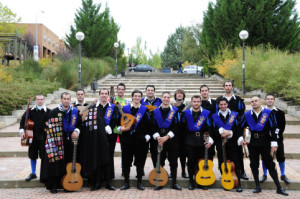
Aren’t they a handsome group? This is the Cuenca Campus University Tuna. Use of this photo is with permission from the generous folks at CuencaOn, a communications service of the University of Cuenca. You can follow them on Facebook at https://www.facebook.com/cuencaon
One of my favorite grad student memories is of the first time I ever heard the university tuna. It was a magical and wonderful moment that I shall never forget. (Spoiler alert—this is not about chicken of the sea!) A group of us was sitting at an outdoor café in El Barrio Húmedo of León as the sun was setting when suddenly we heard male voices singing in wonderful harmony, accompanied by music from guitars, lutes, mandolins, tambourines, an accordion, and a double bass. Their voices were strong and echoed off the thick stone walls of the buildings around us that were many hundreds of years old, and these voices were clearly drawing nearer. My friends all began exclaiming that the university tuna was arriving, and of course, I began looking around, not quite sure what to expect. Then I saw them: about a dozen, or maybe 15 men, clearly students, dressed in Shakespearean-style clothing. They had on black leather shoes, black stockings and either knickerbockers or puffy shorts made of black velvet with vertical satin folds of yellow or purple (the colors of the University of León ). They also wore black button-down and fitted jackets with pointy white collars protruding, and a leather belt around their waist secured with a square, silver buckle. The sleeves of their coats were tight fitting from the wrist to just above the elbow, at which point they suddenly became puffy, like the trousers, with bright satin folds. A brightly colored sash, folded in the shape of a “V”, was draped over their chests. Most of them also wore majestic black velvet capes, the thick ones, lined with satin, which reached almost all the way to the ground. Pinned to their capes were many different colored roses made from satin ribbons, and attached to the roses were long stretches of ribbon, like streamers, hanging the length of the cape so that as the person walked, all of the streamers flew out behind, like adoring fans waving to them. It was an amazing sight.
Once the tuna had gathered around our table, (because, of course, my friends immediately alerted them that the Americana, the only one in the city, was there) they began singing a song that I had never heard before, and which became one of my favorites: Clavelitos. It’s about a guy asking his sweetheart to share her flower of a mouth, the honey of her lips, with him, and promising that he will always bring her clavelitos, little carnations. It ends with him reminding her that if there ever comes a day when he doesn’t bring her these flowers, she mustn’t think that anything is wrong, but just know that he was unable to get them that day.
It turns out that different colleges within each university across the country have their own tunas, which are like singing fraternities. According to the Tuna Universitaria de Salamanca website, (The tuna of the University of Salamanca) when this, the oldest and most famous of Spanish universities, opened in the early 1200’s, there were some groups of students called sopones (which I will translate as “soupers”) who were so poor that they would serenade the neighboring convents and plazas in exchange for their daily meal of a bowl of soup and a few coins with which they could use to pay for their studies. They usually carried around their own wooden spoon and fork, hoping for a meal, and these utensils eventually became the symbol of all of the university Tunas. Later, in the 1300’s, there were groups of students “who didn’t crack a book or go to any classes; indeed, their guitars never left their fingers, they were very entertaining and sung many a sonnet, and always seemed to have a new melody” as described by Guzmán de Alfarache. Two hundred years later, in the 1500’s, it was the world famous Spanish author, Miguel de Cervantes, who in his book “Tia Fingida” describes a particular Tuna group which has, along with their string instruments, about a dozen cow bells. Cervantes surmises that it must have been their intention, and he felt sure that they would achieve it, to wake up the entire neighborhood and make them come out to their balconies to be serenaded.
But my words don’t do tunas justice. In these next few paragraphs I have embedded links to YouTube videos of tuna groups performing, and you can access them by clicking on the colored words. This first one is the Tuna from the College of Law from the University of Albacete singing “Don Quijote”, in homage to Miguel de Cervantes, for the reason I mentioned above. You can really hear the power of their voices. The introduction takes the first minute of the video, so you might want to fast forward over that part if you don’t understand Spanish, and get to the music. I really liked it.
This second link is the Tuna from the College of Medicine at the University of Salamanca. They are playing in a hall in the university and you can see both their typical costumes as well as the wonderful university setting, with the colorful tiles on the walls and the different shields. It’s an ideal backdrop for their music.
This third video is the Tuna from the Law School of the University of Huelva, singing a song called “Maria, la Portuguesa” which is about a Portuguese woman named Maria who has left and broken their heart. They are performing on a stage, which I find strange as I always saw tunas walking around campus or the city, but it turns out that every year there are tons of competitions of tunas from different universities—I would love to go to one of these someday.
Nowadays there are also tunas outside of the university setting, many of which will play at weddings, and I found several YouTube videos of tunas playing for the couple emerging as newlyweds, or to the bride the night before the wedding. The concept of tunas has even been exported to Europe and Latin America. So the next time you go to Spain, no matter which city you visit, look up the local tunas and go watch them perform–I’m sure you’ll love it!
If you enjoyed this blog post, you might also like my series of novels, Bueno, Sinco and Brujas, which takes place in Santander, Spain.



